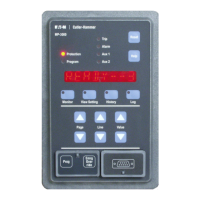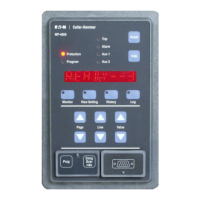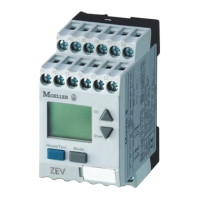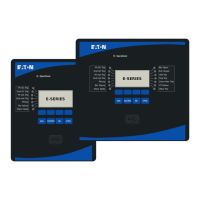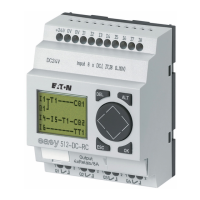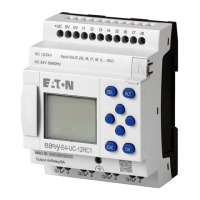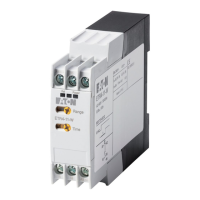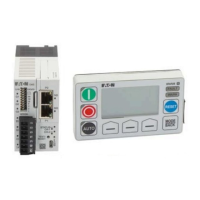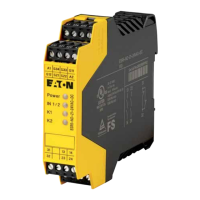For more information visit: www.cutler-hammer.eaton.com
Page 9-3
Effective 10/02 IL17562BH04
• Locked-rotor amperes of 6.1 times FLA
• Maximum allowable stall or locked-rotor time of 15 seconds, cold
start
• Ultimate trip level of 100 percent of FLA (service factor = 1.0)
• Motor running; normally loaded at 90 percent of FLA
• Underload protection at 60 percent of FLA with a 5-second run delay
• Jam protection at 180 percent of FLA with a 5-second run delay
The MP-3000 recognition of the transition from start to run has no
impact on this protection curve, but defines when the displays and
indications change from START to RUN. For a reduced-voltage starter,
the transition function also defines when the AUX2 output relay
switches the starter from reduced to normal running voltage. See 9.2.1
below. The user might elect to transition on time (e.g. set P5L7 to TRN
TIME and P5L6, TRNT=10 seconds) or current (e.g. set P5L7 to TRN I
and P5L5, TRNC to 130 % of FLA), among other options.
Figure 9.5 shows the impact of a stator RTD measurement. Look at the
time period after 60 seconds (near the top). When RTDs report low
stator temperature, the motor can run continuously with current well
above (to the right of) the UTC line. The lower the stator temperature,
the higher the acceptable sustained current moves beyond UTC -
200% of FLA in the example. A hotter stator, perhaps caused by a high
ambient temperature or a cooling blockage, shifts the curve to the left
and lowers the acceptable level of I
2
t. Be sure to set a suitable RTD
temperature trip value (WD T) according to 9.1.8 below; a setting of
OFF causes the relay to revert to the non-RTD algorithm even if RTDs
are connected.
9.1.5 Load Shedding Function
In some applications, the MP-3000 can forestall a jam alarm or trip, or
a thermal trip, by sending a signal to the process to reduce loading.
The load-shedding function, if enabled, will close or open the AUX1
contact to shed process load when the motor load current goes above
the load-shed threshold LSPU, P9L1, for a time exceeding the load-
shed run delay LSDL, P9L3. This could, for example, be connected to
stop flow of material into the driven process until the load current drops
below the load-shed dropout threshold LSDO, P9L2 for time LSDL,
P9L3.
Set the load-shed pickup current LSPU, P9L1 comfortably below the jam
trip level. It may be useful to set it below UTC, P1L4, particularly if RTDs
are not used. See Section 5 explanation for settings P9L1 to P9L3, and
for imposed relationship rules on load shedding pickup, dropout, and time
delay settings.
9.1.6 Long Acceleration Time
The user can temporarily defeat the I
2
t thermal protection limit after a
start by setting a Long Acceleration Time delay (LAT, P5L10). This can
be a dangerous setting which blocks thermal tripping and holds the
bucket at a 100% level if the load takes a long time to reach running
speed. An example is a motor spinning a large centrifuge. In using
LAT, the user is taking advantage of the partial cooling from airflow
produced by motor spinning at below-normal speed, as compared to
unfanned heating of a locked rotor. The motor must be rated for this
severe starting duty. Also, the user must insure that the motor actually
has begun to spin well before the locked-rotor time has expired. This
is accomplished by connecting a zero-speed switch to Discrete Input 1
and setting P5L11 ZSW = ON. The zero-speed switch is a contact that
is closed when the motor is at rest, and opens as the motor begins to
spin, usually at 5-10% of running speed. If ZSW is set to ON and the
MP-3000 does not see the contact open in ½ the locked-rotor time
setting, it trips the motor.
WARNING
TURN OFF LAT UNLESS THE APPLICATION SPECIFICALLY
DEMANDS IT. USE A ZERO-SPEED SWITCH WITH LAT. USING AN
LAT SETTING GREATER THAN LOCKED-ROTOR TIME WITHOUT A
ZERO-SPEED SWITCH WILL TEMPORARILY DEFEAT THERMAL
PROTECTION, AND RUIN THE MOTOR IF THE ROTOR ACTUALLY
IS LOCKED.
If LAT is used, check the settings of transition time TRNT, P5L6 and jam
start delay JMSD, P3L7 to be sure they are coordinated with the
prolonged starting cycle.
9.1.7 Using The Starting Current Profile Function
If the MP-3000 is communicating with a Cutler-Hammer PowerNet host
computer, the user can upload the actual time history of the starting
current from the moment of a particular start to a time well past the set
locked-rotor time. The actual current-versus-time profile can be
visually checked against the cold-start protection curve, which
PowerNet plots for comparison. The PowerNet plot also includes the
long-acceleration extension of the thermal curve, and the jam trip limit.
The profiled starting current is the average rms phase current.
The MP-3000 stores the last four starting current profiles. This profile
data cannot be read on the front-panel display.
9.1.8 Thermal Protection by Direct Measurement
The effects of the motor winding temperature alarm and trip (P2L2 and
P2L3) settings, which can be used with RTDs, are not shown in
Figure 9.5. These direct temperature functions protect independently
of the I
2
t algorithm. For the thermal algorithm to take advantage of the
stator RTDs, the thermal direct tripping must be turned on by setting a
suitable temperature for trip, not OFF. The settings for these functions
should be based on the recommended maximum stator insulation
temperature, as indicated by the motor manufacturer’s insulation
classification on the nameplate.
Table 9-1 Example Insulation Temperature Classes (from
NEMA MG-1)
NOTE: Rising winding temperature has to travel through the insulation
and stator iron to heat the RTD. When setting stator tempera-
ture alarm and direct thermal trip temperatures, keep in mind
that the actual hottest-spot insulation temperature may be 5 to
15 degrees C above the hottest RTD measurement. This
additional temperature rise above insulation rating may cause
the insulation to age twice as quickly as it would if kept within
rating. Set thermal trip temperature a little below insulation
rating for longest motor life.
Class A B F H
Ambient Temp., deg. C 40 40 40 40
Allowable Rise, deg. C 60 80 105 125
Hot Spot Allowance, deg. C 5 10 10 15
Hot Spot Temp., deg. C 105 130 155 180
